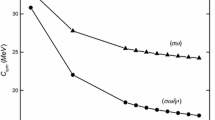Conclusions
Unrestricted Dirac-Fock Theory is capable of obtaining magnetic interaction energies with high precision in ordinary and muonic atoms. The hyperfine anomalies thus obtained may be compared with those measured in muon spin-precession experiments. Although these experiments are generally carried out in solids, the measured anomalies can be compared directly with the Dirac-Fock calculations if care is taken that the muonic atom and the equivalent Z-1 atom are both at substitutional sites in the lattice so that solid state effects will cancel.
Similar content being viewed by others
References
Yamazaki, T., Hayano, R.S., Kono, Y., Imazato, J., Nagamine, K., Kohn, S.E., and Huang, C.Y., Giant hyperfine anomaly between bound negative muon and Rh nucleus in Pd metal, Phys. Rev. Letters42 (1979) 1241–1245.
Freeman, A.J. and Watson, R.E., Hyperfine interactions in magnetic materials, in: Rado, G.T. and Suhl, H. (eds.) Magnetism (Academic Press, New York, 1965), vol. IIA, chap. 4.
Mallow, J.V., Desclaux, J.P., and Freeman, A.J., Dirac-Fock method for muonic atoms: transition energies, wave functions, and charge densities, Phys. Rev. A17, (1978) 1804–1809.
Fricke, B., On the screening of muons by electrons in muonic atoms, Nuovo Cimento Lett.2, (1969) 859–862.
Vogel, P., Zehnder, A., Carter, A.L., Dixit, M.S., Hincks, E.P., Kessler, D., Wadden, J.S., Hargrove, C.K., McKee, R.J., Mess, H., and Anderson, H.L., Measurement of electron screening in muonic lead, Phys. Rev. A15 (1977) 76–79.
Rosenthal, J.E., and Breit, G., The isotope shift in hyperfine structure, Phys. Rev.41 (1932) 459–470; Crawford, M.F. and Schawlow, A.L., Electron-nuclear potential fields from hyperfine structure, Phys. Rev.76 (1949) 1310–1317.
Bohr, A. and Weisskopf, V.F., The influence of nuclear structure on the hyperfine structure of heavy elements, Phys. Rev.77 (1950) 94–98.
Freeman, A.J., Weinert, M., Desclaux, J.P., Mallow, J.V., “Breit Interaction Determination of Muonic Hyperfine Anomalies, Large but not Giant”, Lett. to the Editor to appear in J. Magn. Magn. Matl.
Author information
Authors and Affiliations
Rights and permissions
About this article
Cite this article
Mallow, J.V., Desclaux, J.P., Freeman, A.J. et al. Relativistic self-consistent field theory for muonic atoms: The muonic hyperfine anomaly. Hyperfine Interact 8, 455–461 (1981). https://doi.org/10.1007/BF01037510
Issue Date:
DOI: https://doi.org/10.1007/BF01037510




